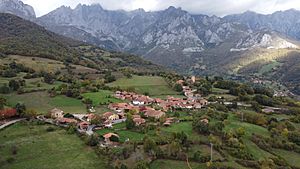Mogrovejo facts for kids
Quick facts for kids
Mogrovejo
|
|
|---|---|
|
village (pueblo) and neighborhood council (junta vecinale)
|
|
 |
|
| Country | |
| Autonomous communities of Spain | |
| Provinces of Spain | Cantabria |
| Comarcas of Spain | Liébana |
| Judicial districts of Spain | San Vicente de la Barquera |
| Municipalities of Spain | Camaleño |
| Elevation | 460 m (1,510 ft) |
| Population
(2008)
|
|
| • Total | 44 |
| Time zone | UTC+1 (CET) |
| • Summer (DST) | UTC+2 (CEST) |
| Dialing code | 942 |
Mogrovejo is a charming small village located in the municipality of Camaleño, within the beautiful region of Cantabria, Spain. In 2008, it was home to about 44 people.
Contents
Exploring Mogrovejo's Location
Mogrovejo sits high up, about 460 meters (that's about 1,509 feet) above the sea. It's nestled in the amazing Picos de Europa mountains, on a flat area inside the Liébana valley. You can see the Ándara massif from there. The village is only 4 kilometers (about 2.5 miles) away from Camaleño, which is the main town of the municipality.
You can get to Mogrovejo by taking road CA-887. This road branches off from the main road CA-185, which connects the towns of Fuente Dé and Potes.
A Glimpse into Mogrovejo's Past
For a long time, until the 1200s, documents called Mogrovejo by a different name: "Luarna." This was the name of an old family that lived there. A famous saint, Turibius of Mogrovejo, came from this family.
In the 1800s, a book called a geographic dictionary, written by Pascual Madoz, mentioned that Mogrovejo was part of a larger area. This area included eight smaller neighborhoods or villages. These places, like Redo, Los Llanos, and Besoy, are still separate communities today.
The entire village area of Mogrovejo is very special. It's recognized as a site of cultural interest and a historical site. This means it has important history and buildings.
Discovering Mogrovejo's Monuments
Mogrovejo is officially recognized as a historical site and a site of cultural interest. This means it has many old and important buildings to see.
- The Tower of Pedro Ruiz de Mogrovejo: This is a medieval tower built in the late 1200s. It's the oldest building still standing in the village.
- Our Lady of the Assumption Church: This church was built in the 1600s. It has a rectangular shape and a special ceiling with curved arches. Inside, you'll find a beautiful altar from the Baroque period and a crucifix from the 1500s. The altar also shows the coat of arms (a special symbol) of Mogrovejo. Look for a sculpture of a flaming Virgin Mary from the late 1400s and a Gothic-Flemish image called "La Milagrosa" from the 1400s.
- Old Mansions: You can see many grand houses from the 1600s and 1700s. These mansions often have fancy iron balconies. Some are surrounded by tall walls with impressive entrances. One famous mansion belonged to Vicente de Celis and has the shield of the Estrada family from the 1500s.
- Traditional Houses: Many ordinary houses in Mogrovejo are built in a style typical of the Liébana region. The upper floor often has open spaces. Some houses have walls made of poles woven together and covered with clay, creating a space for hay. In some of these homes, you can reach the second floor using outdoor stairs, which is a style influenced by the Asturias region. Other interesting old buildings include several round bread ovens and a barn.
Famous People from Mogrovejo
- Turibius of Mogrovejo (1538-1606): He was an important religious figure.
- Santo Toribio de Liébana: He was a bishop and a lord of Mogrovejo. He is known for fighting alongside Don Pelayo, a famous historical figure.
Images for kids
See also

- In Spanish: Mogrovejo para niños



